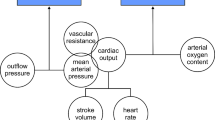Summary
In 33 patients with acute deep venous thrombosis of the lower extremity, all verified by phlebography, and in 36 healthy subjects arterial inflow, venous volume and maximum venous outflow were measured by mercury-strain gauge plethysmography.
The measurements were performed simultaneously in both legs at the calf and foot level with a cuff pressure of 60 mm Hg for 4 min.
In contrast to thrombotic occlusions proximal to the knee and multi-level thromboses, which could be identified by a significantly (p<0.001) reduced venous volume and maximum venous outflow (measurement at the calf level), isolated calf vein thromboses could not be detected even by sensing from the foot level or only if all three deep veins of the calf were occluded.
The best diagnostic criterion for proximal deep venous thrombosis was the correlation of maximum venous outflow and venous volume (83% right positive), if these parameters were determined from the calf.
The results indicate that deep calf vein thrombosis can be detected, even if sensed from the foot, only in cases with cross sectional thrombotic occlusions.
Similar content being viewed by others
Literatur
Aschberg S (1973) Crural venous obstruction or incompetence. Acta Chir Scand [Suppl] 436:1–78
Barnes RW, Hokanson EE, Wu KK, Hoak JC (1977) Detection of deep vein thrombosis with an automatic electrically calibrated strain gauge plethysmograph. Surgery 82:219–223
Barnes RW, Collicott PE, Mozersky DJ, Sumner DS, Strandness DE (1972) Noninvasive quantification of maximum venous outflow in acute thrombophlebitis. Surgery 72:971–979
Bergquist E, Bergquist D, Bronge A, Dahlgren S, Hallböök T (1973) Diagnosis of the venous thrombosis of the lower limb. Upsala J Med Sci 78:191–199
Boijsen E, Eiriksson E (1968) Plethysmographic and phlebographic findings in venous thrombosis of the leg. Acta Chir Scand [Suppl] 398:43–47
Dahn I, Eiriksson E (1968) Plethysmographic diagnosis of deep venous thrombosis of the leg. Acta Chir Scand [Suppl] 398:33–42
Ehringer H (1979) Die akute Becken-Bein-Venenthrombose. In: Ehringer H (ed) Venöse Abflußstörung. Enke, Stuttgart, S 485–491
Franzeck UK, Tom JC, Bernstein EF, Fronek A (1983) Outflow/inflow ratio of the calf — Index of venous circulation. In: Angiology — new developments (in press)
Glaser V (1939) Eine Apparatur zur elektro-optischen Registrierung der Atembewegungen. Klin Wochenschr 18:1156–1157
Hallböök T, Ling L (1972) Resting blood flow at deep venous thrombosis. Acta Chir Scand 138:581–584
Hallböök T, Göthlin J (1971) Strain gauge plethysmography and phlebography in diagnosis of deep venous thrombosis. Acta Chir Scand 137:37–52
Hull R, Taylor DW, Hirsh J, Sackett DL, Powers P, Turpic A, Walker I (1978) Impendance plethysmography: The relationship between venous filling and sensitivity and specifity for proximal vein thrombosis. Circulation 58:898–902
Thulesius O (1979) Früherkennung der tiefen Unterschenkelvenenthrombose mit nicht-invasiver Technik. VASA 8:226–230
Wheeler HB, O'Donnell JA, Anderson FA, Benedict K (1974) Occlusive impendance phlebography — A diagnostic procedure for venous thrombosis and pulmonary embolism. Prog Cardiovasc Dis 17:199–205
Whitney RJ (1949) The measurement of changes in human limb volumes by means of a mercury-in-rubber strain gauge. J Physiol 109:5p-6p
Young AE, Henderson BA, Phillips DA, Couch NP (1978) Impendance plethysmography: its limitations as a substitute for phlebography. Cardiovasc Radiol 1:233–239
Author information
Authors and Affiliations
Additional information
Die Autoren danken der Schweizerischen Gesellschaft für Phlebologie für ihre Unterstützung
Rights and permissions
About this article
Cite this article
Franzeck, U.K., Hagenbuch, R. & Bollinger, A. Vergleichende plethysmographische Untersuchungen arterieller und venöser hämodynamischer Parameter an Unterschenkel und Fuß bei tiefer Beinvenenthrombose. Klin Wochenschr 61, 233–241 (1983). https://doi.org/10.1007/BF01496129
Received:
Accepted:
Issue Date:
DOI: https://doi.org/10.1007/BF01496129




